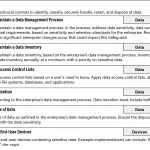As businesses transition to hybrid and multi-cloud setups, vulnerabilities arising from misconfigurations and security gaps are escalating, attracting attention from bad actors.
In response, the US National Security Agency (NSA) issued a set of ten recommended mitigation strategies, published earlier this year (with support from the US Cybersecurity and Infrastructure Security Agency on six of the strategies).
The recommendations cover cloud security, identity management, data protection, and network segmentation. Let‘s take a closer look:
1. Uphold the Cloud Shared Responsibility Model
First on the NSA’s list is upholding the Cloud Shared Responsibility Model. This defines the responsibilities between cloud service providers and their customers, detailing who is accountable for which aspects of data protection, infrastructure management, and security.
By following this model, companies can drive transparency, clarify roles, and facilitate collaboration between providers and users.
Having a clear understanding of their responsibilities helps customers implement the security measures and controls they need to protect their data and applications. For providers, it highlights the importance of maintaining robust infrastructure and stringent security protocols.
2. Use Secure Cloud IAM Practices
Using secure cloud identity and access management (IAM) practices is another crucial element in safeguarding sensitive data, ensuring compliance, and improving general system efficiency. It protects against unauthorized access and helps to maintain the integrity of cloud-based systems.
Part of this is enforcing the principle of least privilege, which only gives users the permissions they strictly need to do their jobs.
By employing robust IAM protocols, entities can ensure that only authorized users can access their resources and data while lowering the risk of breaches and insider threats.
3. Use Secure Cloud Key Management Practices
Next on the list is secure cloud critical management practices, which ensure the confidentiality, integrity, and availability of proprietary data stored in cloud environments. Encryption keys, at the foundation of securing data at rest, can only be protected effectively with robust key management.
These practices also enable firms to securely share data with trusted parties while maintaining control over access and usage and boost the resilience of cloud-based systems by safeguarding against data loss or corruption.
4. Implement Network Segmentation and Encryption in Cloud Environments
The NSA also recommends implementing network segmentation and encryption in cloud environments.
Network segmentation involves dividing the cloud infrastructure into smaller, isolated segments, restricting the lateral movement of threats, and minimizing the potential impact in the event of a security breach.
Encryption is critical in securing data in transit and at rest within cloud environments, because encrypting data ensures that even if unauthorized actors intercept it, they cannot decipher its contents without the correct encryption keys.
5. Secure Data in the Cloud
Data is the lifeblood of modern entities, containing sensitive information such as intellectual property, customer records, financial data, and proprietary information.
As businesses increasingly migrate their operations to the cloud for scalability, flexibility, and cost-effectiveness, ensuring the security of all this data becomes crucial.
Securing data in the cloud involves implementing robust encryption, access controls, authentication tools, and data loss prevention measures to protect against unauthorized access, data breaches, and cyber threats.
6. Defending Continuous Integration/Continuous Delivery (CI/CD) Environments
Also making the Top 10 list is defending CI/CD environments. The NSA believes this is crucial in today’s rapidly evolving digital landscape, where software development and deployment processes are becoming more and more automated and interconnected.
While these pipelines streamline the delivery of software updates and upgrades, they are attractive targets for bad attackers hoping to exploit vulnerabilities and disrupt operations.
Therefore, defending these environments is essential to protecting the integrity and security of software development processes and involves measures such as code analysis, vulnerability scanning, access controls, and encryption.
7. Enforce Secure Automated Deployment Practices through Infrastructure as Code
Enforcing secure automated deployment practices through Infrastructure as Code (IaC) emerged as key.
IaC allows companies to define and provision infrastructure resources using code, facilitating consistent, scalable, and repeatable deployments.
By enforcing secure practices within the code, businesses can mitigate the risk of configuration errors, vulnerabilities, and misconfigurations that may lead to security breaches or downtime.
8. Account for Complexities Introduced by Hybrid Cloud and Multi-Cloud Environments
In today’s digital landscape, where businesses depend on cloud computing to power their operations, accounting for the complexities introduced by hybrid cloud and multi-cloud environments is also crucial.
The diversity of these flexible environments comes with challenges, such as interoperability issues, data security worries, and management complexity.
Understanding and effectively managing the intricacies of hybrid and multi-cloud environments is vital for modern enterprises wanting to maintain an edge while reducing risk in an evolving tech landscape.
9. Mitigate Risks from Managed Service Providers in Cloud Environments
Another critical step is mitigating risks from managed service providers (MSPs) in cloud environments.
MSPs are pivotal in managing and securing cloud infrastructure, applications, and services for businesses. However, entrusting third-party providers introduces potential vulnerabilities, such as data breaches, service outages, or compliance violations.
These risks can be mitigated by implementing robust risk mitigation strategies such as vendor assessments, contractual agreements with stringent security requirements, continuous monitoring and auditing of MSP activities, and establishing clear incident response protocols.
10. Manage Cloud Logs for Effective Threat-hunting
At number 10 on the NSA’s list is managing cloud logs for effective threat hunting. Cloud logs are excellent sources of information, offering insights into system activities, user behaviors, and potential security incidents within cloud environments.
By effectively managing these logs, entities can detect unusual patterns, pinpoint potential threats, and respond swiftly to possible risks.
Leveraging advanced analytics and machine learning algorithms on cloud logs enables proactive threat hunting, allowing security teams to anticipate and neutralize threats before they become a problem.
All these points highlight how harnessing the many benefits of the cloud can make companies more efficient and secure, but only if done correctly.
These steps are fundamental for every cloud customer to stay secure and compliant.
Editor’s Note: The opinions expressed in this guest author article are solely those of the contributor and do not necessarily reflect those of Tripwire.
This post was originally published on the 3rd party site mentioned in the title of this this site





